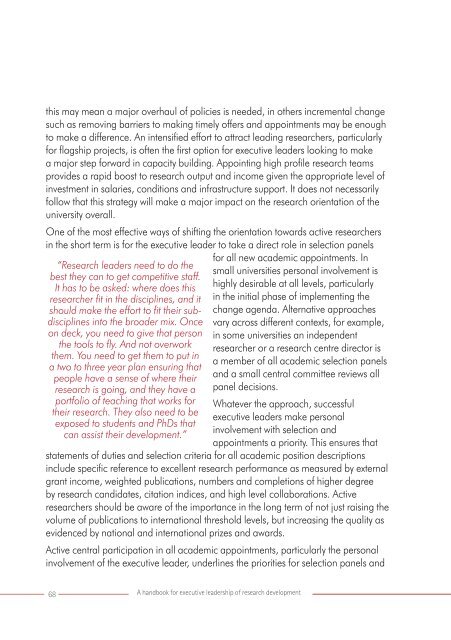handbook-executive-leadership-of-research-development-pdf-v10
handbook-executive-leadership-of-research-development-pdf-v10
handbook-executive-leadership-of-research-development-pdf-v10
You also want an ePaper? Increase the reach of your titles
YUMPU automatically turns print PDFs into web optimized ePapers that Google loves.
this may mean a major overhaul <strong>of</strong> policies is needed, in others incremental changesuch as removing barriers to making timely <strong>of</strong>fers and appointments may be enoughto make a difference. An intensified effort to attract leading <strong>research</strong>ers, particularlyfor flagship projects, is <strong>of</strong>ten the first option for <strong>executive</strong> leaders looking to makea major step forward in capacity building. Appointing high pr<strong>of</strong>ile <strong>research</strong> teamsprovides a rapid boost to <strong>research</strong> output and income given the appropriate level <strong>of</strong>investment in salaries, conditions and infrastructure support. It does not necessarilyfollow that this strategy will make a major impact on the <strong>research</strong> orientation <strong>of</strong> theuniversity overall.One <strong>of</strong> the most effective ways <strong>of</strong> shifting the orientation towards active <strong>research</strong>ersin the short term is for the <strong>executive</strong> leader to take a direct role in selection panels“Research leaders need to do thebest they can to get competitive staff.It has to be asked: where does this<strong>research</strong>er fit in the disciplines, and itshould make the effort to fit their subdisciplinesinto the broader mix. Onceon deck, you need to give that personthe tools to fly. And not overworkthem. You need to get them to put ina two to three year plan ensuring thatpeople have a sense <strong>of</strong> where their<strong>research</strong> is going, and they have aportfolio <strong>of</strong> teaching that works fortheir <strong>research</strong>. They also need to beexposed to students and PhDs thatcan assist their <strong>development</strong>.”for all new academic appointments. Insmall universities personal involvement ishighly desirable at all levels, particularlyin the initial phase <strong>of</strong> implementing thechange agenda. Alternative approachesvary across different contexts, for example,in some universities an independent<strong>research</strong>er or a <strong>research</strong> centre director isa member <strong>of</strong> all academic selection panelsand a small central committee reviews allpanel decisions.Whatever the approach, successful<strong>executive</strong> leaders make personalinvolvement with selection andappointments a priority. This ensures thatstatements <strong>of</strong> duties and selection criteria for all academic position descriptionsinclude specific reference to excellent <strong>research</strong> performance as measured by externalgrant income, weighted publications, numbers and completions <strong>of</strong> higher degreeby <strong>research</strong> candidates, citation indices, and high level collaborations. Active<strong>research</strong>ers should be aware <strong>of</strong> the importance in the long term <strong>of</strong> not just raising thevolume <strong>of</strong> publications to international threshold levels, but increasing the quality asevidenced by national and international prizes and awards.Active central participation in all academic appointments, particularly the personalinvolvement <strong>of</strong> the <strong>executive</strong> leader, underlines the priorities for selection panels and68 A <strong>handbook</strong> for <strong>executive</strong> <strong>leadership</strong> <strong>of</strong> <strong>research</strong> <strong>development</strong>



